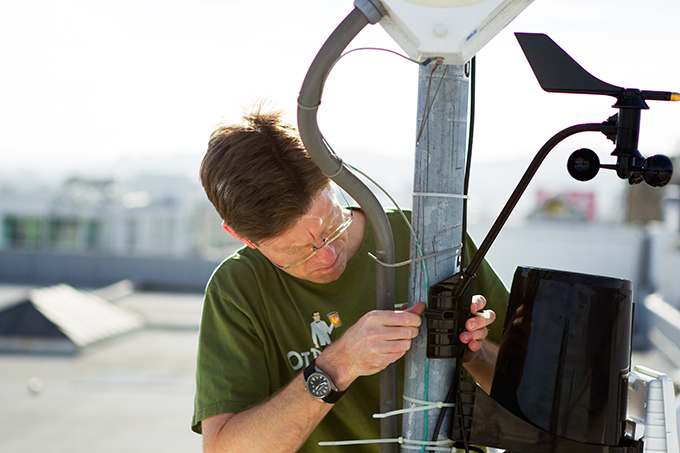It’s a comfortable 63.3 degrees on the roof of Wired headquarters, with a slight 3-mph breeze, and the barometer is at 30.14 inches and rising.
A few blocks away, it’s 61.1 degrees and there’s a 4-mph breeze from the northwest. There was a little mist yesterday, 0.06 inches of precipitation to be exact.
And I know all this even though I’m 20 miles away and inside.
Welcome to the world of super-precise microclimate measurement. It’s all possible, thanks to the thousands of amateur weather stations installed all around the world, which are increasingly linked to the internet and to one another. Someday, this network might give me the ability to tailor weather forecasts not just to my town, but to the very block I’m on.
The Davis Vantage Pro2 we’re using to track the weather at Wired is one of the more expensive weather kits available, but its precision pays off.
Upstairs, there’s an array of environmental sensors, including a thermometer, an anemometer, and a rain gauge all house within an ugly but sturdy shell. We strapped ours to a metal pole about 12 feet above the roof of our office building.
It’s solar-powered and has enough battery power to last all night and through cloudy days, so you don’t need to run electricity to it. And it transmits data to the Vantage Pro2 console wirelessly, so you don’t need data cables either: Just find a suitable pole, strap it up there, and forget about it.
Downstairs, the console picks up data transmitted by the sensors and adds data gathered indoors, including indoor temperature and barometric pressure. You can stare at the console and watch its rudimentary graphs, but such data quickly grows dull for all but the most committed weather nuts. What you really want to do is upload that data to the internet.
To do that, we used a Davis WeatherLink data logger and an Ambient Weather server module to transmit the weather data from the console to Weather Underground, a weather information site and community.
It was a bit tricky to set up, so we first had to use the data logger to pipe the data to a nearby PC running the WeatherLink software to make sure the bits were flowing. Once that was working, we reconnected the data logger to the Ambient Weather module, which is connected directly to our cable modem’s router. From that point on, we didn’t need to use the PC any more.
Weather Underground, which loaned us the equipment, is building a network of weather-data-collecting nodes like ours. The company says it’s currently tracking around 13,400 sites in the United States and almost 20,000 worldwide. Many of those are accessible through Weather Underground’s website, which got a facelift on February 2 — Groundhog’s Day, of course — making it far easier to get information at a glance from its wealth of data.
Eventually, Weather Underground says it wants to use the data stream from each of these amateur weather stations to improve and hyper-localize official weather forecasts. For instance, if the data shows that your location is consistently 4 degrees warmer than the official forecast on summer afternoons, you could use that information to create a more precise forecast for everyone around you.
For now, such advanced features aren’t available — but you can browse through individual weather stations, including Wired’s, and see how conditions change from neighborhood to neighborhood. That’s like catnip for weather geeks.
It also has more immediate, practical implications. If you’re managing an office building like ours, having hyper-local data like this might help you create more efficient air-conditioning and heating schedules. If you have a vacation home, you could install a weather station there and be able to check on conditions before you hit the road on Friday afternoon.
Or, if you live in a part of the world with intensely variable microclimates, such as San Francisco, weather stations like these can help you decide how to dress for the office. That’s no small thing, when temperatures can vary by 10 or 20 degrees from one side of the city to the other.
Track Wired’s weather: We’re station KCASANFR113 on wunderground.com.
WIRED Incredibly precise measurements of temperature, precipitation, barometric pressure, and wind speed and direction. Solar power and wireless transmission means no wires to connect. Expandable — plug UV and solar-radiation sensors into the station. Once set up, system transmits data seamlessly to Weather Underground.
TIRED Setup requires a great deal of patience, as it took us hours to find the right spot, secure the sensors, and set up the internet connection using a data logger. Wireless connection sometimes dropped depending on where we put the console. Expensive.
Photos: Keith Axline/Wired.com
Read the original: Stick It to the Weatherman With Your Own Personal Forecasts | Product Reviews | Wired.com.
